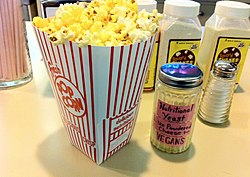

| Nutritional value per 15 g | |||||||||||||||||||||||||||||||
|---|---|---|---|---|---|---|---|---|---|---|---|---|---|---|---|---|---|---|---|---|---|---|---|---|---|---|---|---|---|---|---|
| Energy | 250 kJ (60 kcal) | ||||||||||||||||||||||||||||||
5 g | |||||||||||||||||||||||||||||||
| Sugars | 0 g | ||||||||||||||||||||||||||||||
| Dietary fibre | 3 g | ||||||||||||||||||||||||||||||
0.5 g | |||||||||||||||||||||||||||||||
8 g | |||||||||||||||||||||||||||||||
| |||||||||||||||||||||||||||||||
| Other constituents | Quantity | ||||||||||||||||||||||||||||||
| Cholesterol | 0 mg | ||||||||||||||||||||||||||||||
Bob's Red Mill brand, manufacturer reported values. [1] See also SR LEGACY data for yeast (active dry #1103594) for an idea about pre-fortification values and nutrients not reported above. SR surveys are performed by unbiased USDA personnel. | |||||||||||||||||||||||||||||||
| †Percentages estimated using US recommendations for adults, [2] except for potassium, which is estimated based on expert recommendation from the National Academies [3] | |||||||||||||||||||||||||||||||
Nutritional yeast (informally called nooch [4] ) is a deactivated (i.e., dead) yeast, often a strain of Saccharomyces cerevisiae , that is sold commercially as a food product. It is sold in the form of yellow flakes, granules, or powder, and may be found in the bulk aisle of natural food stores. It is used in vegan and vegetarian cooking as an ingredient in recipes or as a condiment. [5]
Contents
It is a source of some B-complex vitamins and contains trace amounts of several other vitamins and minerals. [6] It is often fortified with vitamin B12.
Nutritional yeast has a strong flavor described as nutty or cheesy for use as a cheese substitute. [7] It may be used in preparation of mashed potatoes, tofu, or popcorn. [8]
Nutritional yeast is a whole-cell inactive yeast that contains both soluble and insoluble parts, which is different from yeast extract. Yeast extract is made by centrifuging inactive nutritional yeast and concentrating the water-soluble yeast cell proteins which are rich in glutamic acid, nucleotides, and peptides, the flavor compounds responsible for umami taste.[ citation needed ]